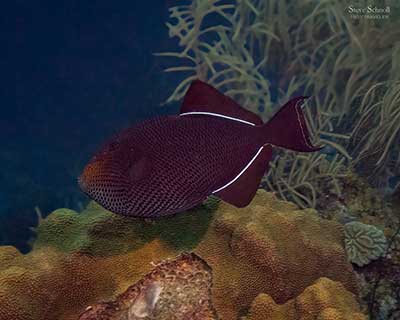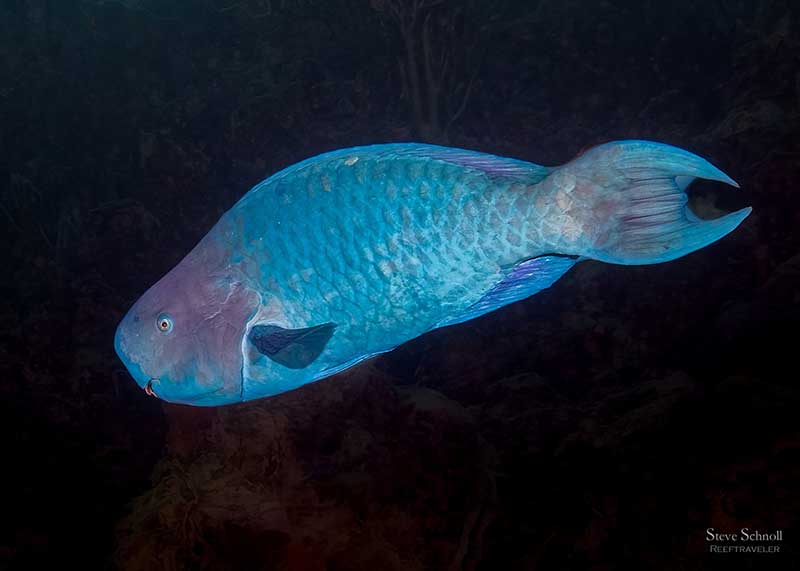Fish photography can be a challenging endeavor.
Some fish are notoriously shy. Some dart away faster than the blink of an eye. Others are curious and may swim around you, but will seldom give you a facial shot (the barracuda and the porcupine fish come to mind here).
If you are looking to improve your fish portraits, or even if you are just starting out, below are a few strategies you can employ to maximize your chances of getting the perfect shot. But first, please remember that we are guests in the underwater environment. It is our duty as stewards of the ocean to avoid disturbing or harassing marine life, to avoid touching or damaging creatures and coral and to leave the smallest possible footprint underwater.
Tips for better fish portraits.
- Get Close to the Subject – This may be the most important piece of advice for fish portraits. If you aren’t close to your subject, you have almost no chance of capturing a sharp, compelling image.
- Regulate Your Breathing– Try to take slow, deliberate breaths. Many fish are afraid of the hissing and gurgling noises that one makes while scuba diving.
- Approach Your Subject Slowly– Approach your subject in a slow, cautious and deliberate manner. You may need to stop and watch before you move in closer. Time and patience are key to successful underwater photography. Let your subject approach you if possible.

- Maintain Situational Awareness – You may have sighted a rare species, which is naturally an exciting moment. However, for your own safety as well as your dive buddy’s, please remember your basic diving skills. Maintain good buoyancy and watch your depth. Do not descend too deep in pursuit of a subject. Likewise, if you spot a fish at a shallower depth, beware of ascending too quickly. These may sound like basic concepts, but we have heard stories of experienced divers incurring serious harm by ascending too quickly in pursuit of a subject. Also, please do not harm the underwater habitat or harass sea life in pursuit of a shot. And remember that your flash is harmful to the fish’s eyes, so please resist the urge to go full paparazzi on that frogfish or seahorse.
- Increase Shutter Speed and Shoot Full Manual if Your Camera Supports it – The best way to clearly capture quickly moving subjects is to set your own aperture, ISO and shutter speed. We recommend starting with a shutter speed of 1/250, an aperture between 4.0 – 5.6 and an ISO of 100-200 for fish portraits in clear, tropical water such as in Bonaire. Many lower end compact cameras may not have these features and may only have automatic modes.
- Background and White Balance are Important – In order to make a pleasing shot, your background matters. It isn’t solely the subject that makes a shot come to life. If you are shooting RAW, it may be easy to fix some background disturbances or problems. A stray fin from a diver may be easy to remove, excess noise can be reduced, and you can often darken your background while maintaining a nice exposure on the subject.

And as for white balance, if you are not using an automatic underwater mode for white balancing, make sure that you are using post-processing software that will help in adjusting your balance. Have you ever seen an underwater photo with a pervasive purple or lilac cast? Or a photo in which everything appears blue (even subjects and backgrounds that are other colors)? In general, this is what you are trying to avoid. The Bonaire ocean should not appear purple.
- Study Fish Behavior – Take the time to get to know your subject. Is it skittish? Does it repeat a certain behavior pattern? Does it have a mate? If you dive the same sites often, you will start to become familiar with the critters.
- Know Your Camera– Shutter lag time, auto focus lag time, and flash recycle time are important things to know when shooting moving subjects like fish. If you aren’t familiar with your camera and its settings, study the manual.
- Focus on the Eyes– Keep the focus on your subject’s eyes. Watch your depth of field. If it’s too shallow, you risk losing focus or clarity on other important features of the fish.
- Minimize Direct Eye Contact with the Fish– Some fish (and many other animals) feel threatened by direct eye contact and will take defensive measures. Your goal is to make the fish comfortable with your presence, while not interfering with its natural behaviors. Keep your eyes on the camera’s viewfinder or display screen.
Incorporate these tips into your next photography session.
We hope that these tips will help you take your fish photography to the next level. Please feel free to share your own tips by sending us an email.
(Source: Bonaire Insider, Photography by Meredith and Steve Schnoll)








